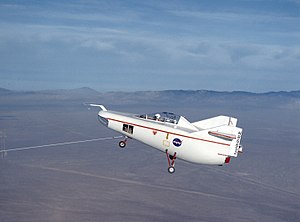NASA M2-F1
| M2-F1 | |
|---|---|
 |
|
| Role | Lifting body technology demonstrator |
| Manufacturer | Dryden Flight Research Center |
| Designer | Ames Research Center |
| First flight | 16 August 1963 |
| Retired | 16 August 1966 |
| Status | On display |
| Primary user | NASA |
| Number built | 1 |
| Unit cost |
US$30,000
|
| Variants |
Northrop M2-F2 Northrop M2-F3 |
The NASA M2-F1 was a lightweight, unpowered prototype aircraft, developed to flight test the wingless lifting body concept. It looked like a "flying bathtub," and was designated the M2-F1, the "M" referring to "manned" and "F" referring to "flight" version. In 1962, NASA Dryden management approved a program to build a lightweight, unpowered lifting body prototype. It featured a plywood shell placed over a tubular steel frame crafted at Dryden. Construction was completed in 1963.
The lifting-body concept originated in the mid-1950s at the National Advisory Committee for Aeronautics' Ames Aeronautical Laboratory, Mountain View, California. By February 1962, a series of possible shapes had been developed, and R. Dale Reed was working to gain support for a research vehicle.
The construction of the M2-F1 was a joint effort by Dryden and a local glider manufacturer, the Briegleb Glider Company. The budget was US$30,000. NASA craftsmen and engineers built the tubular steel interior frame. Its mahogany plywood shell was handmade by Gus Briegleb and company. Ernie Lowder, a NASA craftsman who had worked on Howard Hughes' H-4 Hercules (or Spruce Goose), was assigned to help Briegleb.
Final assembly of the remaining components (including aluminum tail surfaces, pushrod controls, and landing gear from a Cessna 150, later replaced by Cessna 180 landing gear) was done at the NASA facility.
The wingless, lifting body aircraft design was initially conceived as a means of landing a spacecraft horizontally after atmospheric reentry. The absence of wings would make the extreme heat of reentry less damaging to the vehicle. Rather than using a ballistic reentry trajectory like a Command Module, very limited in manoeuvering range, a lifting body vehicle had a landing footprint the size of California.
...
Wikipedia
